 W
WThe chain whip is a weapon used in some Chinese martial arts, particularly traditional Chinese disciplines, in addition to modern and traditional wushu. It consists of several metal rods, which are joined end-to-end by rings to form a flexible chain. Generally, the whip has a handle at one end and a metal dart, used for slashing or piercing an opponent, at the other. A cloth flag is often attached at or near the dart end of the whip and a second flag may cover the whip's handle. The flag or flags adds visual appeal and produces a rushing sound as the whip swings through the air. The rushing noise also helps the user with identifying the location of the other end, since the weapon moves too fast to be normally noticed by human eyes.
 W
WThe three most common types of Chinese polearms are the ge (戈), qiang (槍), and ji (戟). They are translated into English as dagger-axe, spear, and halberd. Dagger-axes were originally a short slashing weapon with a 0.9 to 1.8 m long shaft, but around the 4th century BC a spearhead was added to the blade, and it became a halberd. The spear is also sometimes called a mao (矛), which is sometimes used to designate polearms with a wavy snake-like spearhead. There was another polearm weapon known as the pi (鈹), translated into English as either sword-staff or long lance, that was used from ancient times until the Han dynasty. It was essentially a short sword attached to a stick. From the Warring States period onward, the length of Chinese polearms varied from around 2.8 m to 5.5 m, however there is no specific designation for a pike in the traditional Chinese lexicon. A very long spear is just called a long spear.
 W
WThe dagger-axe is a type of pole weapon that was in use from the Shang dynasty until the Han dynasty in China. It consists of a dagger-shaped blade, mounted by its tang to a perpendicular wooden shaft. The earliest dagger-axe blades were made of stone. Later versions used bronze. Jade versions were also made for ceremonial use. There is a variant type with a divided two-part head, consisting of the usual straight blade and a scythe-like blade.
 W
WDeer horn knives, also known as crescent moon knives or duck blades, are specialised Chinese bladed weapons consisting of two steel crescents crossing. They are used in Chinese martial arts. This crossing produces four curved, clawlike points, one of which is extended as the "main" blade. The practitioner grips the wrapped middle of the lengthened crescent with the other acting as a hand guard. They are relatively short weapons that are easily concealable in traditional Chinese clothing, and are usually trained in pairs, one for each hand.
 W
WEmeici are a traditional Chinese martial arts weapon. They are a pair of metal rods with sharp ends used for stabbing; they are typically mounted on a detachable ring worn on the middle finger, allowing them to spin and be elaborately manipulated.
 W
WThe Green Dragon Crescent Blade is a legendary weapon wielded by the Chinese general Guan Yu in the 14th-century historical novel Romance of the Three Kingdoms. It is a guandao, a type of traditional Chinese weapon.
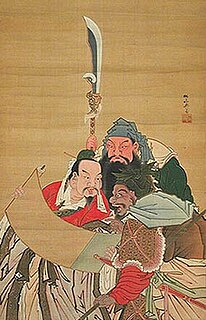 W
WA guandao is a type of Chinese pole weapon that is used in some forms of Chinese martial arts. In Chinese, it is properly called a yanyuedao, the name under which it always appears in texts from the Song to Qing dynasties such as the Wujing Zongyao and Huangchao Liqi Tushi. It is comparable to the Japanese naginata and the European fauchard or glaive and consists of a heavy blade with a spike at the back and sometimes also a notch at the spike's upper base that can catch an opponent's weapon. In addition there are often irregular serrations that lead the back edge of the blade to the spike. The blade is mounted atop a 1.5 m to 1.8 m (5–6 foot) long wooden or metal pole with a pointed metal counter weight used to balance the heavy blade and for striking on the opposite end.
 W
WA gun is a long Chinese staff weapon used in Chinese martial arts. It is known as one of the four major weapons, along with the qiang (spear), dao (sabre), and the jian. It is called, in this group, "The Grandfather of all Weapons". In Vietnam, the gun is known as Côn in Vietnamese martial arts.
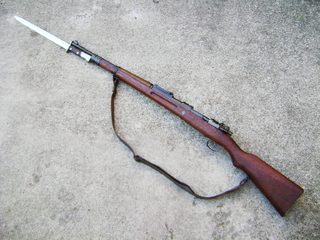 W
WThe Hanyang M1935 bayonet is a bayonet used on the Chinese Chiang Kai-Shek rifle. It is based on the Mauser S84/98 III bayonet used on German Gewehr 98 rifles and derivatives.
 W
WThe term Jacob's staff, also known as cross-staff, a ballastella, a fore-staff, or a balestilha, is used to refer to several things. In its most basic form, a Jacob's staff is a stick or pole with length markings; most staffs are much more complicated than that, and usually contain a number of measurement and stabilization features. The two most frequent uses are:in astronomy and navigation for a simple device to measure angles, later replaced by the more precise sextants; in surveying for a vertical rod that penetrates or sits on the ground and supports a compass or other instrument.
 W
WThe langxian was a branched, multi-tipped spear with blades attached to the branches. The blades could be dipped in poison. The langxian was a weapon well suited for defense, as it would be difficult for an opponent to assault the wielder without risking contact with the blades.
 W
WThe meteor hammer, often referred to simply as meteor, is an ancient Chinese weapon, consisting at its most basic level of two weights connected by a rope or chain. One of the flexible or "soft" weapons, it is referred to by many different names worldwide, dependent upon region, construction and intended use. Other names in use include dai chui, flying hammer, or dragon's fist. It belongs to the broader classes of flail and chain weapons.
 W
WThe Nangun is a variation of the application of the "northern Chinese staff", which is featured in contemporary wushu exercises and forms. It is based on staff techniques coming from Southern Chinese martial arts. Its movements stress hitting, in contrast to the cutting and swinging techniques of the northern staff.
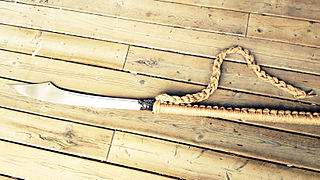 W
WPodao or pudao is a Chinese single-edged infantry weapon which is still used primarily for training in various Chinese martial arts. The blade of the weapon is shaped like a Chinese broadsword, but the weapon has a longer handle, usually around one to two meters which is circular in cross section. It looks somewhat similar to the guandao.
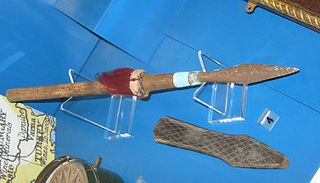 W
WQiang is the Chinese term for spear. Due to its relative ease of manufacture, the spear in many variations was ubiquitous on the pre-modern Chinese battlefield. It is known as one of the four major weapons, along with the gun (staff), dao (sabre), and the jian, called in this group "The King of Weapons".
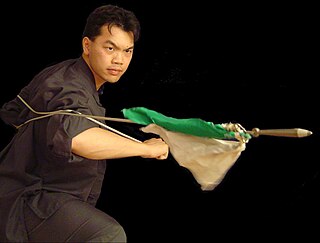 W
WThe rope dart or rope javelin, also known as Jōhyō in Japanese, is one of the flexible weapons in Chinese martial arts. Other weapons in this family include the meteor hammer, flying claws, Fei Tou flying weight, and chain whip. Although the flexible weapons share similar movements, each weapon has its own specific techniques.
 W
WThe Spear of Fuchai is the spear of King Fuchai of Wu, the archrival of King Goujian of Yue. It was unearthed in Jiangling, Hubei in November 1983. The script on it is bird-worm seal script, a variant of seal script that was commonly used in the southern states such as Wu and Yue. The inscription mirrors the text of King Goujian's Sword, except changing the name of the owner and type of weapon. In this case, the text reads, "吴王夫差自作用矛" or "King Fuchai of Wu made for his personal use, this spear."
 W
WThe three-section staff, triple staff, three-part staff, sansetsukon in Japanese, or originally sanjiegun, is a Chinese flail weapon that consists of three wooden or metal staffs connected by metal rings or rope. The weapon is also known as 蟠龍棍 panlong gun, "coiling dragon staff". A more complicated version of the two section staff, the staves can be spun to gather momentum resulting in a powerful strike, or their articulation can be used to strike over or around a shield or other defense.
 W
WWind-and-fire wheels are mêlée weapons, wielded as a pair, associated with Chinese martial arts such as baguazhang and taijiquan. Visually, they are similar to chakrams, although unlike chakrams they are not throwing weapons.